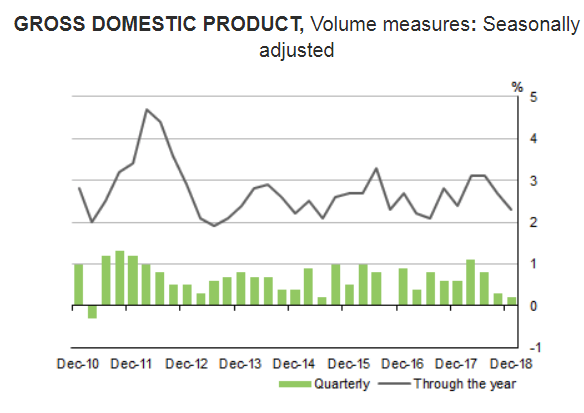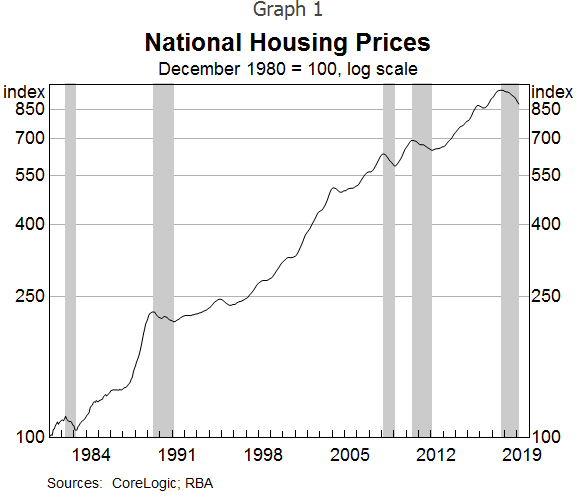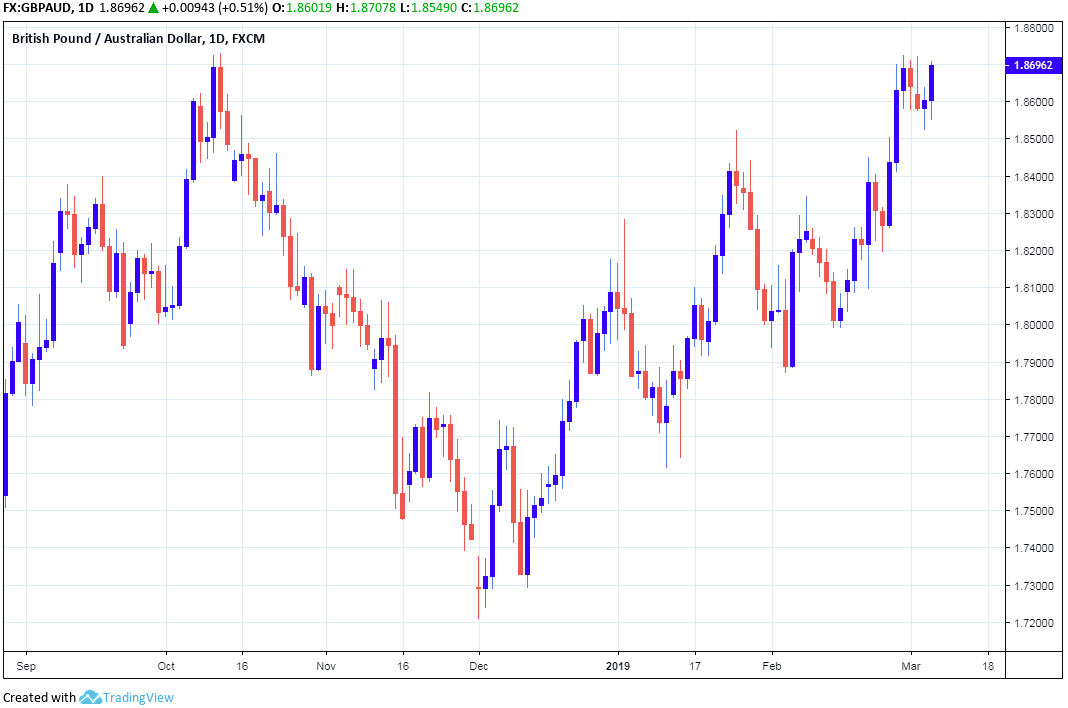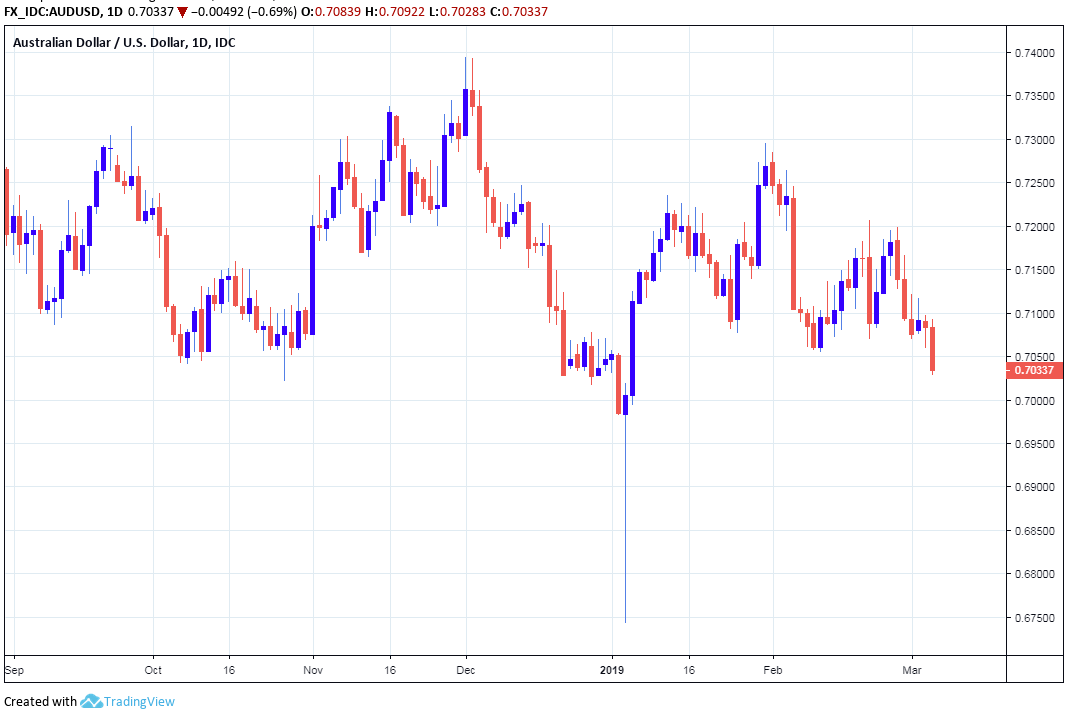Australian Dollar Baulks after GDP Shocker Seals Deal on RBA Rate Cut
- Written by: James Skinner
-

Image © Newtown Grafitti, Reproduced under CC Licensing.
- AUD collapses after economy struggles in Q4, as consumers strike.
- Poor GDP number all but seals deal on 2019 RBA interest rate cut.
- AUD/USD returns to recent lows, GBP/AUD eyes four-month high.
The Australian Dollar collapsed into the Wednesday session, leading the Pound-to-Australian-Dollar rate to test a four-month high, after official data showed the economy slowing sharply late last year as consumers came close to going on strike.
This price action appears to be a sign of things to come for the Aussie because analaysts are saying the poor economic performance means a 2019 Reserve Bank of Australia (RBA) interest rate cut is now close to being a done deal.
Australia's economy grew by just 0.2% during the final quarter last year, down from an already-paltry 0.3% back in the previous period, which means GDP rose by just 2.3% for 2018 as a whole.
That's down from the 2.8% annual pace of growth seen at the end of the third quarter and beneath the RBA's February 2019 forecast for a steady 2.8%, with much of the deceleration having its roots in the household sector.

Above: Australian GDP growth at both annual and quarterly rates.
"Growth is clearly being held down by a weak household sector. Housing construction fell 3.4% q/q, while household consumption was up just 0.4% q/q. Interestingly, household consumption growth was weakest in NSW, where spending grew just 0.1% in the quarter, providing some evidence of a wealth effect," says Felicity Emmett at Australia & New Zealand Banking Group (ANZ).
Emmett and other economists are connecting Australia's slowing economy with an ongoing downturn in house prices, which now appears to be having an impact on household confidence and consumers' willingness to spend.
Policymakers and markets have long been concerned about the impact that house price falls could have on consumer spending and economic growth, with RBA Governor Philip Lowe the latest to opine on the topic.
Lowe said in a speech on Tuesday that household spending has risen faster than income during the last five years, in part because of a huge 50% increase in the price of the average home during the same time period.
He warned that with home prices down 9% in the last year, they could still have further to fall and that this could see household spending decline and savings begin to rise. But he also said the impact should be felt mainly by car dealers and furniture sellers.

"The key domestic demand components were all weak and our economists suggest the door for rate cuts has opened further and the downside risks to their flat profile have increased. Forward now have 30bp of cuts priced in by year-end," says Adam Cole, chief FX strategist at RBC Capital Markets.
Markets care about the GDP data because it reflects rising and falling demand within the economy, which has a direct bearing on consumer price pressures.
Inflation almost always dictates where interest rates will go next, and those are the raison d'être for most currency moves, but the consumer price index has been below the RBA's 2%-to-3% target for years now.
The RBA warned last month it could cut rates this year if the economy deteriorates further and unemployment was to see a sustained increase, which is possible in light of a protracted downturn in the housing market.
It said Tuesday the Australian economy should still grow by around 3% in 2019 and that the unemployment rate will drift lower. Lower unemployment is a prerequisite for wage growth, which is necessary for the RBA to meet its 2%-to-3% inflation target.
"If the slowdown persists, it will challenge the RBA’s more optimistic outlook for the economy," says Lee Hardman, a currency analyst at MUFG. "The case for a rate cut would intensify if there was evidence of negative spill-overs to the labour market as well. Nevertheless, the Australian rate market is becoming more confident a rate cut will be delivered later this year which is weighing on the Aussie."

Above: Pound-to-Australian-Dollar rate shown at daily intervals.
The Pound-to-Australian-Dollar rate was down 0.76% higher at 1.8701 Wednesday and has now risen 3.7% this year, while the AUD/USD rate was -0.79% lower at 0.7030 and is now down -0.3% for 2019. The Aussie was lower against all G10 currencies for the session.

Above: AUD/USD rate shown at daily intervals.
Wednesday's price action came following a risk-off session on Tuesday, which also saw the Aussie offered lower due to the latest developments emerging from China.
The Chinese government said the world's second largest economy could grow at what would be its slowest pace for nearly three decades this year, owing the after effects of the trade war with the U.S. and structural economic deficiencies.
"Though the result is largely as expected, the first thing that strikes us is the wide 50bp range. In other words, if the top end of the range is missed by a big amount, policy makers could still appear as if they’re “on target”," says Stephen Gallo, European head of FX strategy at BMO Capital Markets.
Chinese officials say GDP could grow by as little as 6% this year, and is unlikely to expand by any more than 6.5%, which would be the slowest expansion since the early 1990's if only the lower end of the forecast bracket is achieved.
And that's after the government pumps up the economy with fiscal stimulus it estimates to be worth around 2.2% of GDP. In other words, China's economy is in trouble even if the nation's leadership is succesful in ending the tariff fight with the U.S. that has roiled global markets these last 12 months.
"A set of pro-growth measures are planned despite positive progress in US-China trade talks, which makes us think that either China doesn't have full confidence in a trade truce or that the damages from the trade conflict cannot easily be undone," says Iris Pang, a Greater China economist at ING.
China's Renmimbi, with which Australia's Dollar shares a strong positive correlation, rose only modestly when policymakers unveiled a package of tax cuts worth 2.2% of GDP while Australia's Dollar received no firm bid whatsoever.
The fact Chinese officials are still spending significant sums to prop up the economy suggests either that damage from the trade war with the U.S. is greater than they've let on, or that that they aren't confident the truce due to be formally struck with the White House later this month will last for very long.
Time to move your money? Get 3-5% more currency than your bank would offer by using the services of foreign exchange specialists at RationalFX. A specialist broker can deliver you an exchange rate closer to the real market rate, thereby saving you substantial quantities of currency. Find out more here.
* Advertisement









